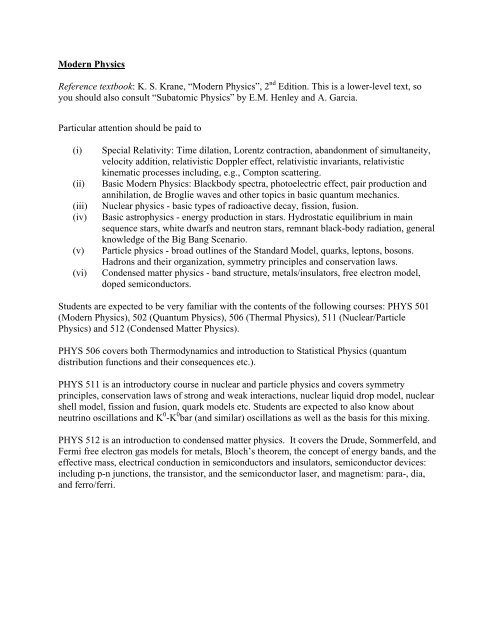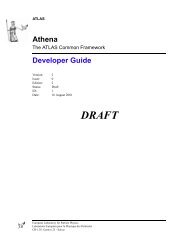Admission to Candidacy Exam Syllabus
Admission to Candidacy Exam Syllabus
Admission to Candidacy Exam Syllabus
Create successful ePaper yourself
Turn your PDF publications into a flip-book with our unique Google optimized e-Paper software.
Modern Physics<br />
Reference textbook: K. S. Krane, “Modern Physics”, 2 nd Edition. This is a lower-level text, so<br />
you should also consult “Suba<strong>to</strong>mic Physics” by E.M. Henley and A. Garcia.<br />
Particular attention should be paid <strong>to</strong><br />
(i)<br />
(ii)<br />
(iii)<br />
(iv)<br />
(v)<br />
(vi)<br />
Special Relativity: Time dilation, Lorentz contraction, abandonment of simultaneity,<br />
velocity addition, relativistic Doppler effect, relativistic invariants, relativistic<br />
kinematic processes including, e.g., Comp<strong>to</strong>n scattering.<br />
Basic Modern Physics: Blackbody spectra, pho<strong>to</strong>electric effect, pair production and<br />
annihilation, de Broglie waves and other <strong>to</strong>pics in basic quantum mechanics.<br />
Nuclear physics - basic types of radioactive decay, fission, fusion.<br />
Basic astrophysics - energy production in stars. Hydrostatic equilibrium in main<br />
sequence stars, white dwarfs and neutron stars, remnant black-body radiation, general<br />
knowledge of the Big Bang Scenario.<br />
Particle physics - broad outlines of the Standard Model, quarks, lep<strong>to</strong>ns, bosons.<br />
Hadrons and their organization, symmetry principles and conservation laws.<br />
Condensed matter physics - band structure, metals/insula<strong>to</strong>rs, free electron model,<br />
doped semiconduc<strong>to</strong>rs.<br />
Students are expected <strong>to</strong> be very familiar with the contents of the following courses: PHYS 501<br />
(Modern Physics), 502 (Quantum Physics), 506 (Thermal Physics), 511 (Nuclear/Particle<br />
Physics) and 512 (Condensed Matter Physics).<br />
PHYS 506 covers both Thermodynamics and introduction <strong>to</strong> Statistical Physics (quantum<br />
distribution functions and their consequences etc.).<br />
PHYS 511 is an introduc<strong>to</strong>ry course in nuclear and particle physics and covers symmetry<br />
principles, conservation laws of strong and weak interactions, nuclear liquid drop model, nuclear<br />
shell model, fission and fusion, quark models etc. Students are expected <strong>to</strong> also know about<br />
neutrino oscillations and K 0 -K 0 bar (and similar) oscillations as well as the basis for this mixing.<br />
PHYS 512 is an introduction <strong>to</strong> condensed matter physics. It covers the Drude, Sommerfeld, and<br />
Fermi free electron gas models for metals, Bloch’s theorem, the concept of energy bands, and the<br />
effective mass, electrical conduction in semiconduc<strong>to</strong>rs and insula<strong>to</strong>rs, semiconduc<strong>to</strong>r devices:<br />
including p-n junctions, the transis<strong>to</strong>r, and the semiconduc<strong>to</strong>r laser, and magnetism: para-, dia,<br />
and ferro/ferri.
















